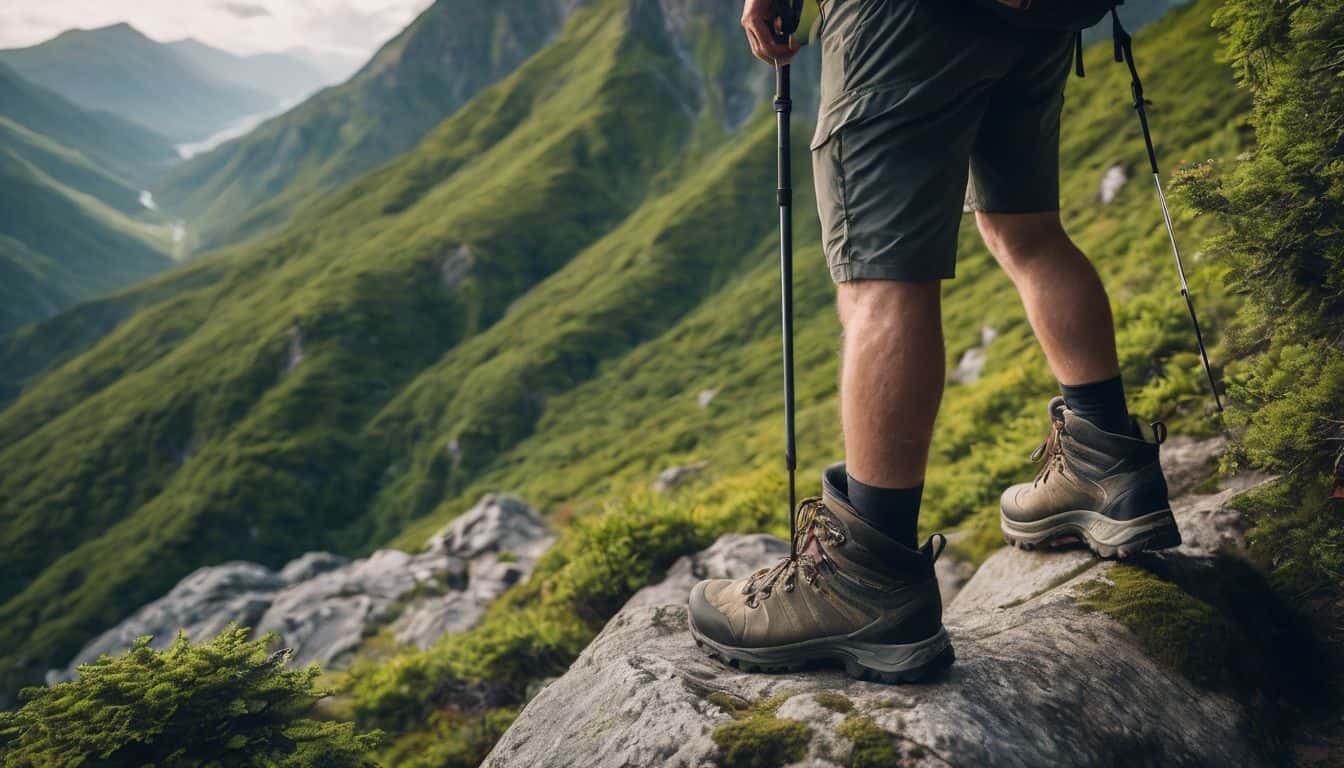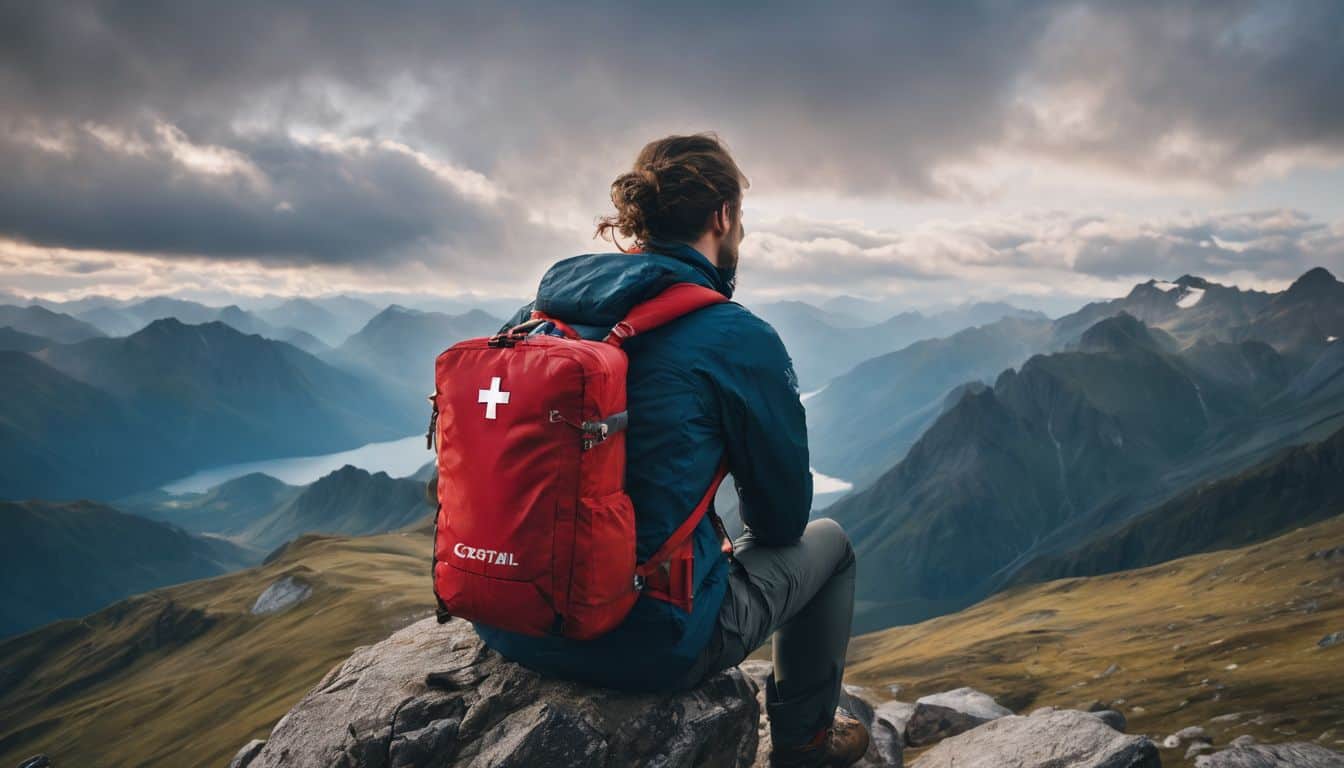Ever found yourself gearing up for a hike and getting stumped at the footwear aisle? Trust me, I totally get it. With more options than leaves on the trees, zeroing in on that perfect pair of hiking shoes can feel as hard as climbing a mountain itself.
Through my own trial and errors along with some solid research, I’ve figured out three key factors to getting it right – comfort, durability and stability. So buckle up! We’re going to walk (quite literally) through these critical 3 tips you need to know before setting foot down your next adventure trail!
Key Takeaways
- When choosing hiking footwear, consider the type of hiking you’ll be doing, the terrain you’ll encounter, the weight of your backpack, the length and pace of your hike, your hiking level, and your physical fitness.
- Different types of hiking require different footwear. For tough hikes or carrying heavy backpacks, sturdy boots with ankle support are recommended. For lighter hikes on well-maintained trails, trail runners or lightweight shoes can provide more flexibility.
- Proper fit is crucial when selecting hiking footwear because everyone’s feet are unique. Consider factors like arch support, traction, cushioning, breathability, waterproof capabilities, toe protection, and a lightweight design to ensure comfort and functionality.
Factors to Consider When Choosing Hiking Footwear
Consider the type of hiking you will be doing, the terrain you will encounter, the weight of your backpack, the length and pace of your hike, your hiking level, and your physical fitness.
Type of hiking
You need different shoes for different types of hiking. A short, easy trail might only need light shoes. But for a tough, long hike you will want strong boots. Choosing the right type of footwear is key to a good hike.
It helps keep your feet safe and makes the hike more fun. So, think about what kind of hikes you like to do before picking out your shoes or boots.
Hiking terrain
Walking on rough ground can be tough. It’s even harder when you have to climb steep hills or dodge tree roots and rocks. This is why your hiking shoes need to be just right for the terrain you’ll be hiking on.
Smooth trails aren’t much work, but rough ones sure are! Trails with lots of bumps and twists ask for strong shoes with plenty of grip. That helps keep you steady over rocky paths and slippery mud.
Your feet carry all your weight, plus your bag too! So think about the ground where you will walk before getting new shoes for a hike.
Weight of backpack
I always take note of my backpack weight when picking out hiking footwear. The shoe’s load capacity plays a big role here. If I bring a light pack, say about 15 to 20 pounds or less, hiking boots do the job well.
They fit avid hikers like me perfectly and are loved by climbers and lightweight enthusiasts too. On other trips where I value weight over anything else, hiking shoes come in handy as they are lighter.
So yes, my backpack’s weight can sway my footwear choice for hikes!
Length and pace of hike
When choosing hiking footwear, it’s important to consider the length and pace of your hike. The duration and intensity of your hike will determine the level of support and comfort you’ll need from your shoes.
For longer hikes or faster-paced ones, you’ll want shoes or boots that provide excellent cushioning and stability to prevent fatigue and foot pain. On shorter, slower-paced hikes, you may be able to get away with lighter, more flexible shoes.
So make sure to assess the length and pace of your hike before selecting your footwear!
Hiking level
When it comes to choosing hiking footwear, your hiking level is an important factor to consider. Different levels of hiking require different types of footwear. If you’re a beginner or prefer lighter hikes, you may opt for lightweight shoes instead of heavy boots.
These lighter options can still provide the necessary comfort and support you need on the trail. However, if you’re more experienced or planning on tackling challenging terrains, hiking boots with good ankle support may be a better choice.
They offer extra stability and protection when navigating rugged paths. So make sure to assess your hiking skill level and choose footwear that suits your needs accordingly.

Physical fitness
Physical fitness is a crucial factor to consider when choosing hiking footwear. It’s important to assess your own physical fitness level before deciding on the type of hiking shoes or boots that will work best for you.
Your physical fitness can affect your endurance, balance, and overall comfort during hikes. Factors such as foot type, injury history, and the weight of the footwear should be taken into account when selecting hiking footwear.
Additionally, evaluating your pack and body weight can help determine how much support and protection your feet will need on the trails. Remember that personal preference in footwear also plays a role in finding the right fit for you.
Guide on Choosing Hiking Footwear

When choosing hiking footwear, it’s important to consider a few key factors. Here are three essential tips for finding the right hiking boots or shoes:
- Consider the type of hiking you’ll be doing: Different types of hiking require different footwear. If you’ll be tackling rugged terrain or carrying a heavy backpack, sturdy hiking boots with ankle support might be your best bet. For lighter hikes on well-maintained trails, trail runners or lightweight shoes could be more suitable.
- Think about your feet and comfort: No two feet are the same, so finding the right fit is crucial. Look for hiking footwear that provides enough room in the toe box and proper arch support. Consider factors like the width of your forefoot and whether you prefer a shoe with zero drop (no height difference between heel and forefoot) or regular drop.
- Prioritize durability and functionality: Hiking footwear should be durable enough to withstand rough conditions and provide adequate protection for your feet. Look for materials that are tough yet breathable, like synthetic uppers or leather with breathable membranes. Consider whether waterproofing is necessary based on the weather conditions you’ll be facing.
Different Types of Hiking Footwear
Hiking footwear comes in various types, including hiking boots, trail runners, and lightweight shoes. Each type has its advantages and disadvantages depending on the type of hiking you plan to do.
To learn more about these options and discover which one is best for you, continue reading!
Hiking boots
Hiking boots are a popular choice for hikers because of their durability and ankle support. They are designed to handle rough terrains and provide stability while carrying a heavy backpack.
Hiking boots come in different styles, including waterproof options for wet conditions. When choosing hiking boots, it’s important to ensure they fit properly, as ill-fitting boots can cause discomfort and blisters.
It’s also worth considering the weight of the boot, as heavier options may tire your legs faster during long hikes. Overall, hiking boots are a reliable choice for those seeking protection and support on challenging trails.
Trail runners
Trail runners are a type of hiking footwear that can be a great option for hikers. They are designed to provide support, flexibility, and protection on different terrains. Trail runners usually have stiffer midsoles, grippy outsoles, and synthetic overlays in the uppers for added durability.
These features make them ideal for faster and more agile hiking.
Compared to traditional running shoes, trail runners offer better traction and durability. They are lighter and more flexible than hiking boots, making them a popular choice among hikers who prefer speed and agility on the trails.
Lightweight shoes
I love using lightweight shoes for hiking! They are comparable in weight to trail runners and much lighter than traditional hiking boots. These shoes are perfect for hikers who prioritize comfort and want a flexible option that molds to their feet.
Don’t worry about sacrificing ankle support or protection, because lightweight trekking shoes still provide those benefits. Plus, they offer great value for hikers looking for a balance between protection and weight.
So if you’re seeking comfortable, lightweight footwear for your hikes, definitely consider giving these shoes a try!
Importance of Proper Fit
Proper fit is essential when choosing hiking footwear because everyone’s feet are unique and finding the right fit can prevent discomfort and potential foot injuries.
No two feet are the same
Each person’s feet are unique, just like a fingerprint. When it comes to choosing hiking footwear, it is important to remember that there is no one-size-fits-all solution. The shape and structure of your feet will play a big role in determining the right shoe for you.
Factors such as arch height, toe length, and width variation can all impact the fit and comfort of a hiking shoe. That’s why it’s crucial to find a pair that provides personalized comfort and support for your specific foot shape.
So don’t settle for anything less than a perfect fit when selecting your hiking footwear.
Ankle support myth
Many people believe that wearing high-topped boots can prevent ankle injuries while hiking. However, this is actually a myth. Research has shown that high-top shoes may not reduce the risk of ankle sprains or injuries without additional taping or external support.
In fact, some experts argue that these types of shoes can limit ankle movement instead of supporting it. While ankle support is important, it may not be as crucial in preventing injuries as previously believed.
Components of hiking footwear
When choosing hiking footwear, it is important to consider the components that make up a good pair of shoes. Here are some key components to look for:
- Arch support: Hiking shoes should provide good arch support to prevent discomfort and fatigue during long hikes.
- Traction: Look for shoes with a strong and durable outsole that provides excellent traction on different types of terrain.
- Cushioning: Adequate cushioning in the midsole helps absorb shock and reduces the impact on your feet and joints.
- Breathability: Hiking shoes with breathable materials allow air to circulate, keeping your feet cool and preventing excessive sweating.
- Waterproof capabilities: Depending on the hiking conditions, you may need waterproof shoes to protect your feet from moisture, such as rain or puddles.
- Toe protection: Some hiking shoes have reinforced toe caps for added protection against rocks, roots, and other obstacles on the trail.
- Lightweight design: Lighter shoes can reduce fatigue and allow for faster movement on the trail.
Current shoe trends and debates
As a hiking enthusiast, you may be interested in the current shoe trends and debates surrounding hiking footwear. One important trend to consider is the growing popularity of lightweight shoes and trail runners for hiking.
These options offer a more agile and flexible feel, allowing you to move quickly on the trails. Another debate revolves around ankle support in hiking boots. While some believe that high-top boots provide better support, others argue that low-top shoes can still offer adequate protection without restricting movement.
When choosing your hiking footwear, it’s essential to prioritize comfort, protection, and stability based on your unique needs and preferences.
Consideration for wide vs narrow forefoot
When choosing hiking footwear, it’s important to consider the width of your forefoot. Narrow and shallow shoes can increase the risk of forefoot injuries. Some hiking boots run narrow, while others run wide.
To avoid discomfort and foot injuries, choose boots that match the width of your feet. If you have wide feet, look for boots that come in different widths around the toe box. This will help accommodate your foot shape and prevent any potential issues on the trail.
Zero drop vs regular drop
When choosing hiking footwear, one important consideration is zero drop vs regular drop. Zero drop shoes have become popular among hikers because they provide a more stable landing platform and better balance compared to regular drop shoes.
Some research suggests that zero drop shoes can help with balance and provide a more natural footstrike. These shoes are designed to mimic walking barefoot and maintain the same foot positioning without a raised heel.
They support a more natural running gait and disperse impact better. With zero drop shoes, you get a natural feel and encourage less dependency on shoe gear.
Energy return
Choosing hiking footwear with good energy return is essential for maximizing performance and reducing fatigue. Wearing heavy backpacking boots can increase oxygen consumption and the amount of energy needed, which can negatively impact your overall hiking experience.
Opting for lightweight shoes or trail runners instead of bulky boots can help improve energy efficiency. These types of footwear provide a more responsive feel and better cushioning, allowing you to conserve energy and hike longer distances without straining your feet and legs.
So, when selecting your hiking footwear, consider its energy return capabilities to enhance your comfort and enjoyment on the trails.
Other Considerations
Consider Leave No Trace principles and how your hiking footwear choice can minimize impact on the environment. Think about durability, shoe fabric options, waterproof vs non-waterproof shoes, keeping feet warm, and blister prevention.
Read more to make sure you’re well-prepared for your next hiking adventure!
Durability
Durability is a crucial factor to consider when choosing hiking footwear. It refers to how long the shoes or boots will last and how well they can withstand tough outdoor conditions.
The materials used in the construction of hiking footwear greatly influence its durability. For example, full-grain leather is known for its excellent durability, making it a popular choice for hiking boots.
A durable boot not only lasts longer but also performs better overall. It provides sturdy support and stability for your joints, which is essential during long hikes or challenging terrains.
Shoe fabric options
When choosing hiking footwear, it’s important to consider the different shoe fabric options available. Here are some options to keep in mind:
- Synthetic materials: Many hiking shoes and boots are made with synthetic fabric, which can be lightweight and breathable. These materials are often quick-drying, making them ideal for wet conditions.
- Synthetic leather: Some hiking shoes incorporate patches of synthetic leather into their design. This helps reduce the weight of the footwear while still providing durability and support.
- Waterproof uppers: If you anticipate hiking in wet or rainy conditions, consider footwear with waterproof uppers. These will help keep your feet dry and comfortable throughout your hike.
- Durability: Look for hiking shoes with strong, durable fabrics that can withstand the rigors of the trail. Reinforced stitching and high-quality materials will ensure your footwear lasts for many hikes to come.
Waterproof vs non-waterproof shoes
When it comes to hiking footwear, the debate between waterproof and non-waterproof shoes is a crucial factor to consider. The choice can significantly affect your comfort and hiking experience.
| Waterproof Hiking Shoes | Non-Waterproof Hiking Shoes |
|---|---|
| Waterproof hiking shoes have membranes like Gore-Tex or eVent. These materials are designed to keep water out. | Non-waterproof hiking shoes typically do not have a membrane and are made of materials that allow for breathability. |
| Despite being designed to keep water out, waterproof boots may fail to keep your feet dry. Sweat trapped by the waterproof membranes can lead to sweaty feet. | Non-waterproof shoes allow sweat to evaporate, potentially leading to drier feet over the course of a hike. |
| Waterproof shoes tend to be heavier due to the additional layers and materials used for waterproofing. | Non-waterproof shoes are typically lighter, adding less weight to your feet and making hiking easier. |
| Waterproof shoes tend to be more expensive due to the addition of high-tech materials. | Non-waterproof shoes can be more affordable, especially for beginners or casual hikers. |
| The drying time for waterproof shoes can be longer due to their design. | Non-waterproof shoes can dry quickly, which is beneficial if you encounter water on your hike. |
| Some hikers prefer waterproof shoes for hiking in wet conditions, or during seasons with a higher chance of rain. | Many hikers choose non-waterproof shoes for dry conditions, or when hiking in hot weather to allow sweat to evaporate. |
Remember, the right choice between waterproof and non-waterproof hiking shoes often comes down to personal preference and the specific conditions of your hike.
Keeping feet warm
To keep your feet warm during hikes, it’s important to choose the right hiking footwear. Look for shoes or boots made with breathable materials that will help wick away moisture from your feet.
Insulated footwear and heat-retaining insoles can also help to keep your feet cozy in colder temperatures. Consider wearing thermal sock liners for extra warmth, and don’t forget about proper sizing and fit – shoes that are too tight can restrict blood flow, making your feet feel colder.
Finally, layering techniques and cold weather accessories like footcare products can provide added protection against the chill. So, make sure to choose hiking footwear that will keep your feet warm and comfortable throughout your outdoor adventures!
Blister prevention
Preventing blisters while hiking is crucial for a comfortable and enjoyable experience. One key tip is to wear thin liner socks under your hiking socks to reduce friction and moisture.
This can help prevent blisters from forming. It’s also important to take care of any hot spots on your feet by immediately covering them with moleskin or a bandage. Investing in the right footwear that fits well is another essential step in preventing blisters.
Make sure to break in your boots before hitting the trail, as this can help reduce the risk of blisters too. So remember, taking these steps for blister prevention will keep your feet happy during your hiking adventures!
Consider Leave No Trace principles
As a hiking enthusiast, it’s important to consider the Leave No Trace principles while exploring the great outdoors. These principles provide guidelines for sustainable practices and responsible camping.
One key principle is proper waste management. Make sure to dispose of your trash in designated bins or take it with you when leaving the trail. This helps minimize your ecological footprint and preserves the natural beauty of the environment.
Another principle to keep in mind is preserving wildlife. Avoid disturbing animals and their habitats by observing from a distance and not feeding them. Respecting their space ensures that they can continue to thrive in their natural habitat.
Furthermore, minimizing campfire impacts is crucial for outdoor ethics. Before starting a fire, check if it’s allowed in that area and only use established fire rings or pits. Remember to fully extinguish any fires before leaving.
Tips for Choosing and Using Hiking Footwear
Stick to what you know and have found comfortable in the past, but also be open to trying new options through trial and error.
Stick to what you know
Stick to what you know. When choosing hiking footwear, it’s important to go with what you’re familiar and comfortable with. Don’t be swayed by the latest trends or what others are wearing.
Stick to the type of shoes that have worked well for you in the past. Every hiker is different, so what works for someone else may not work for you. Trust your own experience and stick with what has proven to be reliable and suitable for your feet and hiking style.
Trial and error
Choosing the right hiking footwear is not always easy. It may take some trial and error to find what works best for you. Don’t be afraid to try different options and learn through experience.
Take a hands-on approach by testing and experimenting with various choices. Evaluate different alternatives, explore different possibilities, and assess what feels most comfortable for your feet.
Remember that no two feet are the same, so what works for someone else might not work for you. By adopting a trial-and-learn approach, you can find the perfect hiking footwear that suits your needs.
Conclusion on Choosing Hiking Footwear
To ensure a successful hiking experience, it is essential to choose the right footwear. By following these three key tips – considering the type of hiking, selecting the appropriate hiking terrain and backpack weight, and paying attention to fit and comfort – you can find the perfect pair of boots or shoes for your outdoor adventures.
So lace up those shoes, hit the trails, and enjoy your time in nature with confidence!
FAQs on Choosing Hiking Footwear
1. What are the essential tips for choosing hiking footwear?
When choosing hiking footwear, consider the fit (make sure it’s snug but not tight), the type of terrain you’ll be hiking on (choose sturdy boots for rough trails and lightweight shoes for easier paths), and ankle support (higher boots offer more stability).
2. How do I know if hiking footwear fits properly?
Properly fitting hiking footwear should have enough room in the toe area, your heel shouldn’t slide up and down when walking, and there should be no pressure points or discomfort.
3. Can I use regular sneakers or running shoes for hiking?
While regular sneakers or running shoes can work for easy trails, they don’t provide as much support and protection as specialized hiking footwear. It’s best to invest in proper equipment to prevent injuries.
4. Are waterproof hiking boots necessary?
Waterproof hiking boots are recommended if you’ll be trekking through wet or muddy terrain. They help keep your feet dry and protect against moisture-related issues like blisters.
5. Do I need to break-in new hiking footwear before using them?
Yes, it’s important to break-in new hiking footwear before embarking on a long hike. Wear them around the house or on shorter walks to allow your feet to adjust and prevent discomfort during longer treks.





Leave a Reply